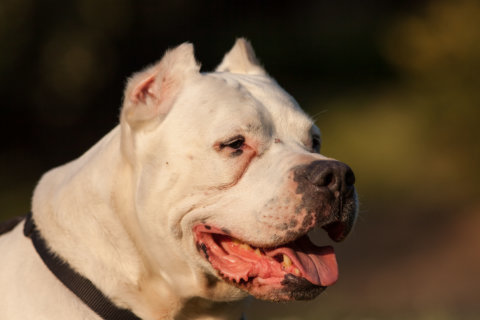WASHINGTON — The longtime owner of a large mixed-breed dog was mauled to death in her D.C. home earlier this week, leaving her husband and neighbors surprised that the dog turned on her. Following her death, and similar dog attacks in the area, veterinarian Dr. Katie Nelson talked to WTOP about what warning signs to look for and what owners can do to prevent aggression.
“What happened this weekend I don’t think we’ll ever truly understand,” Nelson said. “But one thing that we can keep in mind is … if we have a younger dog that is showing signs of aggression, then we typically have a much greater chance of getting them through that, whether it’s through training, working with a professional trainer, working with your veterinarian, or through exercise.”
An “aggressive” dog can exhibit a whole host of behaviors, according to the American Society for the Prevention of Cruelty and Animals, including:
- Becoming very still and rigid
- Barking and growling that sounds threatening
- “Muzzle punch” (the dog literally punches the person with her nose)
- Biting that cause bruises, puncture wounds, or are repeated in rapid succession
Even though dogs don’t always follow a sequence of aggressive behaviors, they rarely bite without giving some warning signs beforehand and they wouldn’t typically lose their temper all of a sudden, the ASPCA said.
Still, there are steps you can take steps to train your dog out of aggression if you ever see these signs, Nelson said.
“Aggression is a huge topic,” Nelson said. “I think we need to focus on what aggression truly is, and we have to realize that it is a range of behaviors. It’s not just the most severe case like what we just saw. There are a lot of warning signs that come with aggression.”
A dog’s warning signs can include showing teeth, lunging without actually making eye contact, nipping or scratching, or even head butting, Nelson said.
In more serious cases of aggression, such as resource-guarding or protective behavior over humans, Nelson recommends that owners work with a trainer and their veterinarian to identify a dog’s triggers and help the dog get through their aggression.
“Is there a true cure for aggression? Not necessarily. But often times when we work to identify what their triggers are — if it’s certain people, if it’s certain times of day, if it’s certain things — then we can get them out of those situations and prevent the behavior in the first place,” Nelson said.
Nelson suggests examining a dog’s history to identify their triggers.
“If you identify the fact that he gets really upset when the UPS guy comes to the door and he’s more likely to show aggression towards the other dog in the house or the child in the house, then that’s a trigger where … when you know that’s going to happen, have him out in the backyard so that trigger doesn’t occur,” Nelson said.
If a dog doesn’t show triggers and is seemingly unprovoked, then Nelson strongly suggests getting a veterinarian involved.
“The difficult times are the ones where they don’t show triggers and they show unprovoked aggression,” Nelson said. “And those are the ones that are often times much more difficult to get through.”
And if you’re unsure about your dogs behavior, Nelson said you should always consult your veterinarian.
While some aggression requires more serious intervention than others, a dog’s aggressive behavior could also be an indication of pent-up energy or old age, which can be eased through training and medication.
“There are other types of situations where they might start to display aggression later in life, whether it’s because they’re ill — they have a thyroid issue, they have arthritis, they have something that’s painful — or maybe they have a degenerative brain disease like cognitive dysfunction or Alzheimer’s-type symptoms that can cause them to display behaviors that they would ordinarily not have in younger days,” Nelson said. “So those situations obviously you deal with the medical issue and hopefully you can get through that.”
Just as there are a wide range of aggressive behaviors, any type of dog can exhibit aggression regardless of breed or size, Nelson said. So it’s important to treat each dog individually.
“I do want to point out that we have to be very careful when we blame a particular breed or a particular type of dog,” Nelson said. “There are more dog bites every year from smaller dogs than there are from larger dogs, however they just cause less damage. We have to treat pets as an individual rather than categorizing them into an entire group and putting a label on them.”







